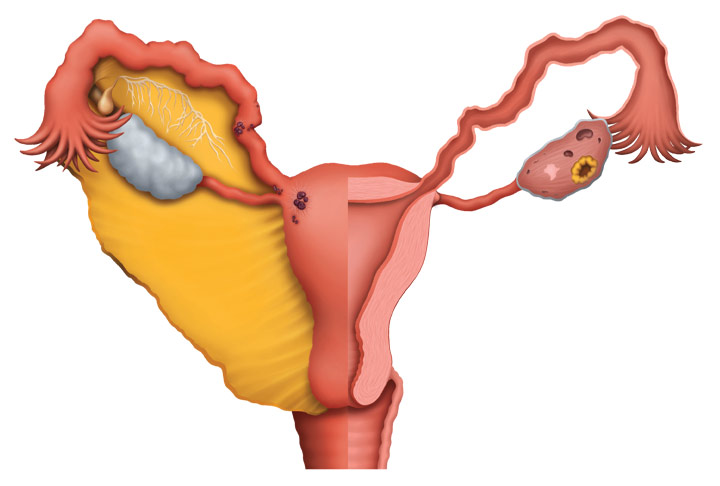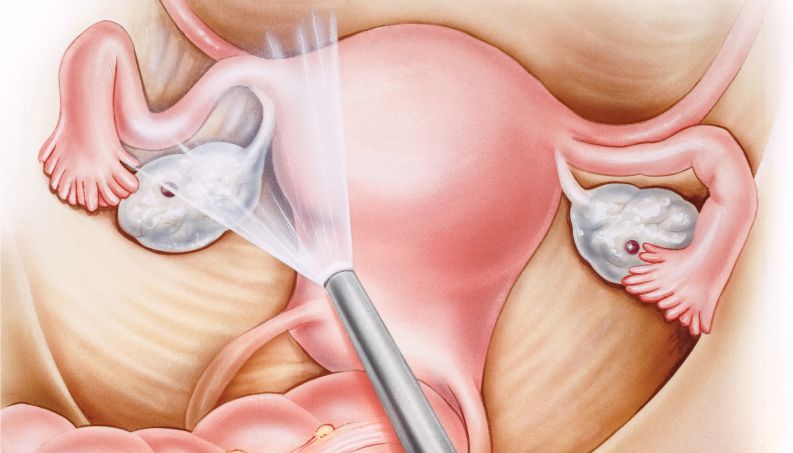This disease occurs in a large number of women of reproductive age (more than 20-30%). According to statistics, endometriosis is the third most common gynecological disease. More often, patients who are diagnosed with uterine fibroids and inflammatory diseases seek help.

It is worth explaining what it is - uterine endometriosis. If the girls know the symptoms of the disease in advance, they will be able to notice its development in a timely manner. This will help to carry out immediate treatment of pathology.
Endometriosis of the uterus. What is an accessible language?
To better understand the development of the disease, it is worth a simpler way to describe it. Inside the uterus is a layer of special muscle tissue called the endometrium. He goes a little beyond. Once in the abdominal cavity, the endometrium extends to the fallopian tubes, ovaries and intestines. This leads to the development of this pathology.
However, when considering types of endometriosis, it is worth considering that in some situations, pathology can spread to more distant organs. In medical practice, there have been cases when the pathology even affected the eyes. In this case, during the period of menstruation in women observed the bloody tears. This is due to the fact that during menstruation, focal lesions of endometriosis also begin to bleed and lead to the appearance of very severe pain.
The development of this pathology negatively affects the well-being of the fair sex. Due to the constant feeling of discomfort in the lower area of the peritoneum, ladies are not able to carry out the usual tasks and experience serious difficulties in their personal lives. Considering in an accessible language what it is - uterine endometriosis, it is worth noting that women with such an ailment have to temporarily abandon intimacy with members of the opposite sex. Also, pathology makes itself felt during work and performing the simplest daily tasks. This leads to the development of depression and poor sleep.
To cope with unpleasant symptoms, many patients begin to take painkillers, and sometimes sedatives. This leads to weakening of the kidneys and clogging of the liver. However, in the absence of proper treatment of endometriosis, a woman has a danger of encountering quite serious problems in the work of the reproductive system. This can lead to big problems when a lady wants to have a baby. More than 40% of women who have been diagnosed with infertility suffer precisely from this pathology.

What else should you know about endometriosis? What features distinguish it? What is this pathology fraught with? It is worth considering that this disease belongs to the category of benign. In a malignant stage, the disease passes very rarely. This means that with timely treatment has a good chance to avoid negative consequences.
Endometriosis Classification of the American Fertility Society
To date, the world uses an updated list of varieties of this pathology, which was compiled by the AFS organization. Based on this, primarily endometriosis is distinguished based on the location of its localization:
- Genital. In this case, the lesion is detected in the genital area.
- Extragenital. This kind of pathology is localized outside the organs of the reproductive system. In this case, foci of pathology can appear in a variety of organs (for example, in the kidneys or lungs).
In turn, a genital-type disease is also divided into types of uterine endometriosis:
- Peritoneal. In this case, we are talking about lesions of the fallopian tubes, ovaries and pelvic peritoneum.
- Extraperitoneal. The lesion spreads to the lower parts of the reproductive system. In this case, the vagina, rectovaginal septum and other organs may be affected.
- Interior. The disease develops in the muscle tissue of the uterus. At the same time, it can grow strongly and acquire the shape of a ball.
Also in the classification of endometriosis, there is a mixed type of pathology. As a rule, it occurs only at an advanced stage of the disease. In this case, different zones of the woman's body may be affected.
In addition, the classification of endometriosis by AFS includes varieties of the disease depending on how the pathology spreads. Based on this, four degrees of the development of the disease are distinguished:
- 1st stage. Only single foci of pathology are observed, which are more often of the superficial type.
- 2nd stage. It is characterized by the appearance of deeper foci. Their number is increasing.
- 3rd stage. Multiple deep foci of pathology can cause the development of cysts. There is a risk that adhesions will appear in the abdominal cavity.
- 4th stage. In this case, very deep foci of lesion appear, which grow in large quantities. A cyst can develop on the ovaries. The resulting adhesions become more dense. Germination of the endometrium into the intestines and vaginal walls occurs. This is the most severe degree of endometriosis. Can she be cured? Theoretically, getting rid of this pathology is possible. However, it is likely that therapy will not bring the desired result.
In addition, today there is a separate classification of endometriosis is an internal type. In this case, there are also 4 stages of the development of pathology:
- 1st stage. It is characterized by a slight spread of foci.
- 2nd stage. Lesions begin to spread to a depth of about ½ of the myometrium.
- 3rd stage. The entire thickness of the endometrium grows.
- 4th stage. The foci begin to extend beyond the uterus and affect the abdominal cavity.
Speaking about the classification of external endometriosis and internal, it is worth noting that the foci are rarely the same in size. In some situations, their size is several millimeters, and sometimes reaches 2-3 centimeters. Also, they do not have a pronounced form. If we talk about the color of the lesions, then, as a rule, they are dark cherry in color with whitish scars at the junction of tissues. The foci ripen cyclically, so they are most clearly manifested during menstruation.

With ovarian endometriosis, specialists pay attention to the appearance of cystic formations filled with dark red liquid. As a rule, foci appear in groups.
There is also a classification of retrocervical endometriosis. This type of pathology is localized in the pelvic organs and often spreads to the intestinal wall.
Common signs of the disease
If you suspect endometriosis, the doctor conducts numerous tests and makes a diagnosis, so if you experience discomfort in the lower abdomen, you should not postpone the visit to a specialist.
The fact is that this pathology is characterized by a huge number of symptoms. Therefore, even a qualified specialist can not always determine the presence of this particular ailment. It happens that the representative of the fair sex does not complain at all, and does not even suspect the presence of endometriosis. In other situations, patients experience severe torment.
If we talk about typical manifestations of the disease, then most often ladies complain of severe pain. They are localized in the lumbar region and the lower region of the peritoneum. In this case, the pain syndrome is different in its intensity. For example, with the onset of menstruation, the discomfort increases significantly. In this case, the women have such severe bouts of pain that they begin to take a large number of painkillers. In addition, discomfort appears during sexual intercourse and bowel movements. In this situation, the pain will be localized in the rectum, perineum and in the pelvic area.
However, this is not the only symptom of endometriosis. Is it possible to determine it by other parameters? Yes, there are a large number of concomitant symptoms that should alert a woman. First of all, pay attention to menstrual irregularities. When this pathology appears, patients note the appearance of spotting brown discharge, which can appear both before menstruation and after their completion. In addition, many note an increase in blood secretions. Menstruation can last longer than usual.
It is also worth noting that infertility is not only a consequence of untimely treatment of pathology, but also one of its symptoms. Some women may try to have a baby for years and use a wide variety of treatment methods. However, until the doctor makes the correct diagnosis, it is impossible to talk about the restoration of reproductive function.
Considering the types of endometriosis and possible signs of its development, it is worth paying attention to such a symptom as intoxication. In this case, the fair sex has severe chills, nausea, fever, pain and severe weakness. If a patient’s blood test is performed, the white blood cell count will be significantly increased.
Specific symptoms
If we talk about signs that are less common, then everything depends on the form of pathology. For example, if a lady suffers from endometriosis of the bladder, then in this case she will go to the toilet more often. With lung damage, hemoptysis is observed during menstruation.

If pathology has affected intestine is enhanced by its peristalsis. Such symptoms lead to the fact that the woman believes that she has all the signs of fibroids. Others even prefer to ignore problems, because they believe that they are caused simply by painful periods.
Reasons for the development of pathology
To date, there are no precisely proven theories regarding the factors that influence the appearance of this ailment. There are only a few theories that are currently being tested. According to them, endometriosis can develop against the background of:
- Abortion
- Intrauterine manipulations.
- Inflammatory diseases of the reproductive system.
- Surgical intervention.
- Procedures for "cauterization" of the cervix.
- Adverse Ecology.
- Anemia
- Metabolic disorders.
Diagnostics
Regardless of the classification of endometriosis, the doctor conducts an external examination of the woman and interviews her. It is very important to list all the symptoms that torment the patient. An additional ultrasound is performed. However, laparoscopy is considered the most effective way to detect endometriosis. This is because the lesions in this case are clearly visible, since they differ in color. Black and white inclusions are inactive. If brown or reddish lesions are detected, then this indicates a pathology.
In the process of laparoscopy, a specialist sequentially examines the pelvis, ovaries, peritoneum, uterine ligaments and other organs. Additionally, a biopsy may be required to ensure that studies are correct.
In the process of diagnosis can be identified:
- Endometrioid cysts. They are also called "chocolate". This is because they are filled with a dark brown liquid.
- Endometrioid nodes. In this case, we are talking about deeper lesions. Nodes of this type are fibrous tissues and smooth muscle cells. These formations do not differ in bleeding or necrosis.
Treatment
It’s worth mentioning right away that it is far from always getting rid of this pathology. In 50% of cases after drug treatment of endometriosis in women, relapse occurs. If an operation is performed, then the probability of recovery increases. In this case, the disease returns only in 20% of cases.
It is worth noting that drug therapy is not able to eliminate the foci of endometriosis. Alternative methods of treatment are also ineffective. When taking pills and some drug charges, only a temporary relief of the most unpleasant symptoms is observed, but the disease still remains.
Also, some ladies believe that medications will help increase the chance of becoming pregnant. However, it is important to understand that drugs only increase the quality of life, eliminating painful symptoms.
When choosing the type of treatment for endometriosis, many factors are taken into account. For example, the doctor specifies whether the representative of the fair sex wants to maintain fertility. The specialist also draws attention to the severity of symptoms. If a woman has already experienced this ailment, then it is necessary to clarify what treatment she underwent for the last time.
Drug therapy
In this case, it is primarily about the removal of pain. It is also necessary to maintain the body in physical form and seek psychological support. As a rule, a specialist prescribes a comprehensive treatment. Combined oral contraceptives have been shown to be effective.
The doctor also prescribes progestogens, gonadoliberin agonists and other drugs.
Danazol
This synthetic-type agent suppresses ovulation and menostasis. It can also cause atrophy of the mucous membranes of the vagina and endometrium. Pelvic pain during menstruation becomes less intense. In addition, there is a decrease in the foci of the endometrium, they cease to germinate deeper. Reduced blood loss, increased levels of red blood cells.

However, this tool can cause uterine bleeding. In addition, a woman may develop minor anabolic effects, acne, swelling, and the appearance of excess weight. In addition, the mammary glands are reduced, the lady's voice becomes lower, more hair begins to grow on the body. This symptomatology is called androgenization. Because of these consequences women often refuse treatment with this drug. However, this tool is considered one of the most effective.
Gestrinon
This is a synthetic steroid hormone. The drug affects the hypothalamus and pituitary gland. The tool is able to suppress the action of hormones in the central nervous system. In addition, Gestrion has an antiestrogenic effect, which does not cause ovulation. Due to this, the ovaries begin to produce less hormones.
After treatment of endometriosis with this agent, women experience the same effects of treatment as when taking Danazol. However, despite the fact that the drug suppresses ovulation, a woman is able to become pregnant. Therefore, in the treatment process, you must not forget about contraception during sexual intercourse.
Mifepristone
The tool is able to save a woman from pain. Usually, the course of treatment is 3 months, however, improvement in the fair sex is observed after the first weeks of taking Mifepristone. This drug reduces bleeding in the foci of the endometrium during menstruation. Accordingly, pain becomes not so unbearable.
Surgical intervention
In some situations, you can not do without the intervention of a surgeon. During the operation, heterotopies are removed. Doctors try not to affect other organs and, if possible, preserve them. This is especially important for women who want to have a baby.
Relapses after surgery are very rare. Therefore, this method is considered the most effective in the fight against endometriosis. After treatment, patients cease to complain of pain. If an ovarian cyst was detected in a lady, then she is removed along with her capsule.
If a woman suffers from a severe stage of endometriosis, then this can lead to infertility. In such situations, surgery becomes the only possible option to avoid this consequence. During the operation, the specialist dissects the adhesions, removes the cysts, restores the anatomical structures, as well as their relationships with each other. However, to return to fertility, and may require additional support activities.
Phytotherapy
Specialists are not opposed to the fact that patients used herbal preparations in the treatment of pathology and the removal of pain. Treatment of this type has several advantages. Herbs do not have such serious contraindications as medications. The exception is only the individual intolerance of a woman. In addition, herbal supplements help strengthen the body and improve the functioning of the immune system. Their cost is much lower, and you can purchase the necessary compounds in almost any pharmacy.

Today on sale there are even special fees that are designed specifically for the treatment of endometriosis. However, before proceeding with the use of such drugs, it is necessary to consult with a specialist and calculate the necessary dosage.
Folk remedies
Such therapy cannot exclude the traditional type of treatment. In addition, it is worth considering that alternative methods of combating pathology can be effective only if we are talking about the initial stages of the development of pathology.
, :
- Acupuncture. . , 10-12 .
- . . , . .
, , , , . . 4 .
, , , , , , .
, :
- .
- .
- 30-45 .
- .
- .
:
- 1 .
- .
- .
- .
- .
- The use of hormonal contraception in order to exclude the possibility of abortion.
- Rejection of bad habits.
During menstruation, experts do not recommend the use of tampons, since they seriously hamper the outflow of blood to the outside, as a result, it is thrown into the fallopian tubes. It is also important to monitor your diet. It is recommended to consume up to 50% of fruits and vegetables. It is also worth drinking less caffeine and carbonated drinks.

If a woman has undergone a course of medical treatment or underwent surgery, then in the recovery process it is worth using the same recommendations. If we talk about when a lady can have a baby, then everything depends on the individual characteristics of the woman. In some cases, the performance of the reproductive system is disrupted forever, and sometimes conception becomes possible after a relatively short period of time.